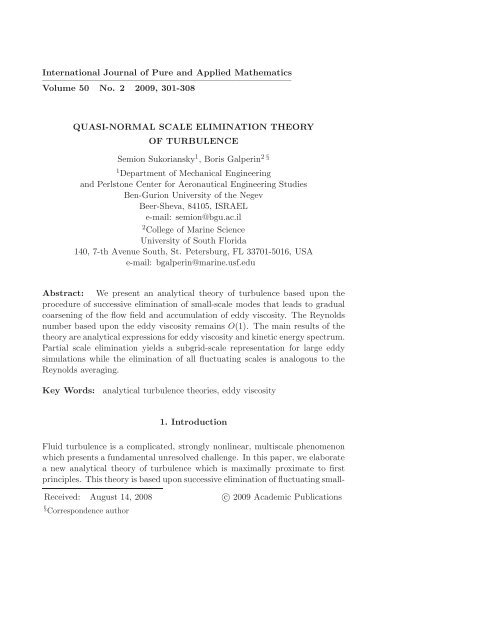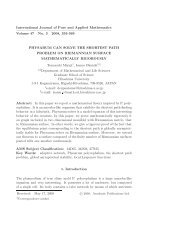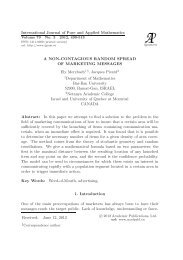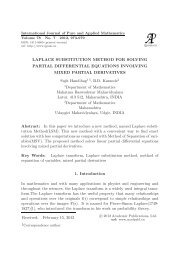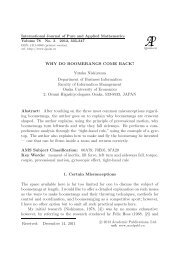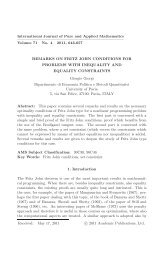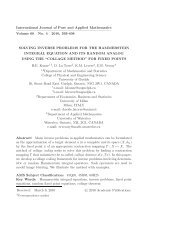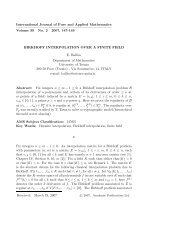QUASI-NORMAL SCALE ELIMINATION THEORY OF TURBULENCE
QUASI-NORMAL SCALE ELIMINATION THEORY OF TURBULENCE
QUASI-NORMAL SCALE ELIMINATION THEORY OF TURBULENCE
You also want an ePaper? Increase the reach of your titles
YUMPU automatically turns print PDFs into web optimized ePapers that Google loves.
International Journal of Pure and Applied Mathematics<br />
————————————————————————–<br />
Volume 50 No. 2 2009, 301-308<br />
<strong>QUASI</strong>-<strong>NORMAL</strong> <strong>SCALE</strong> <strong>ELIMINATION</strong> <strong>THEORY</strong><br />
<strong>OF</strong> <strong>TURBULENCE</strong><br />
Semion Sukoriansky1 , Boris Galperin2 §<br />
1 Department of Mechanical Engineering<br />
and Perlstone Center for Aeronautical Engineering Studies<br />
Ben-Gurion University of the Negev<br />
Beer-Sheva, 84105, ISRAEL<br />
e-mail: semion@bgu.ac.il<br />
2 College of Marine Science<br />
University of South Florida<br />
140, 7-th Avenue South, St. Petersburg, FL 33701-5016, USA<br />
e-mail: bgalperin@marine.usf.edu<br />
Abstract: We present an analytical theory of turbulence based upon the<br />
procedure of successive elimination of small-scale modes that leads to gradual<br />
coarsening of the flow field and accumulation of eddy viscosity. The Reynolds<br />
number based upon the eddy viscosity remains O(1). The main results of the<br />
theory are analytical expressions for eddy viscosity and kinetic energy spectrum.<br />
Partial scale elimination yields a subgrid-scale representation for large eddy<br />
simulations while the elimination of all fluctuating scales is analogous to the<br />
Reynolds averaging.<br />
Key Words: analytical turbulence theories, eddy viscosity<br />
1. Introduction<br />
Fluid turbulence is a complicated, strongly nonlinear, multiscale phenomenon<br />
which presents a fundamental unresolved challenge. In this paper, we elaborate<br />
a new analytical theory of turbulence which is maximally proximate to first<br />
principles. This theory is based upon successive elimination of fluctuating small-<br />
Received: August 14, 2008 c○ 2009 Academic Publications<br />
§ Correspondence author
302 S. Sukoriansky, B. Galperin<br />
scale modes and calculation of compensating corrections to the viscosity. The<br />
theory formulation as well as the computation of the eddy viscosity and kinetic<br />
energy spectrum are presented in the next section. Section 3 is discussion and<br />
conclusions.<br />
2. The QNSE Model and Main Results<br />
We consider homogeneous, isotropic, three-dimensional turbulent flows described<br />
by the Navier–Stokes and continuity equations,<br />
∂ui<br />
∂t<br />
∂ui<br />
+ uj<br />
∂xj<br />
= f 0 i − 1 ∂P ∂<br />
+ ν0<br />
ρ ∂xi<br />
2ui , (1)<br />
∂xj∂xj<br />
∂ui<br />
= 0, (2)<br />
∂xi<br />
where ui is the fluctuating velocity, P is the pressure, ρ is the constant density,<br />
ν0 is the molecular viscosity. Equation (1) is strongly nonlinear. Large-scale instabilities<br />
excite secondary flows that form structures populating smaller scales.<br />
Nonlinear interactions between the structures on different scales generate highly<br />
irregular, stochastic flow field known as turbulence. The force, f0 i (x,t), is an explicit<br />
external forcing that maintains turbulence in a statistically steady state.<br />
This large-scale energy injection generates Kolmogorov cascade down to the<br />
smallest scales. The dynamics of this cascade is independent of the details of<br />
the force.<br />
A space-time Fourier transform of the three-dimensional (3D) velocity field,<br />
ui(x,t), in the domain bounded by the wave number of the viscous dissipation,<br />
kd = O[(ǫ/ν3 0 )1/4 ], ǫ being the rate of the viscous dissipation, is<br />
ui(x,t) = 1<br />
(2π) 4<br />
<br />
dk dω ui(k,ω)exp[i(k · x − ωt)]. (3)<br />
k≤kd<br />
Fourier-transformed continuity equation is<br />
kiui( ˆ k) = 0. (4)<br />
Using this equation, we exclude pressure in the Fourier-transformed equation<br />
(1) and present it as<br />
ul( ˆ k) = G( ˆ k)f 0 l (ˆ k) − i<br />
2 G(ˆ <br />
k)Plmn(k) um(ˆq)un( ˆ k − ˆq) dˆq<br />
(2π) 4, (5)<br />
where ˆ k = (k,ω), ˆq = (q,Ω), and the Einstein summation rule is enforced. The<br />
projector operators,<br />
Pij(k) = δij − kikj/k 2 , (6)
<strong>QUASI</strong>-<strong>NORMAL</strong> <strong>SCALE</strong> <strong>ELIMINATION</strong> <strong>THEORY</strong>... 303<br />
Plmn(k) = kmPln(k) + knPlm(k), (7)<br />
are the result of the incompressibility of the flow field;<br />
G −1 ( ˆ k) = G −1 (k,ω) = −iω + ν0k 2<br />
is the Green function, and δij is the Kronecker δ-symbol.<br />
The system (4), (5) is defined in the entire domain k ∈ (0,kd]. For an<br />
arbitrary wave number Λ ≤ kd and small shell ∆Λ, we define the domains<br />
D < = (0,Λ−∆Λ] and D > = (Λ − ∆Λ,Λ] such that D = (0,Λ] = D < ∪ D > . We<br />
now define slow modes, u < l (k,ω), and fast modes, u> l (k,ω), according to<br />
< u<br />
ul(k,ω) = l (k,ω) for k ∈ D <<br />
u > l (k,ω) for k ∈ D> .<br />
The coarse-grained description of the system is achieved by a systematic procedure<br />
of successive ensemble averaging over the fast modes which we refer to as<br />
the “small scale elimination.” This procedure coarsens the ‘grain’ of the spectral<br />
representation of the flow domain by the measure of D > . Simultaneously,<br />
the viscosity is modified after each iteration. The process starts at Λ = kd<br />
and continues to arbitrarily small Λ. The ensuing coarse-grained equation preserves<br />
the analytical structure of the Navier–Stokes equation but its effective,<br />
or eddy viscosity becomes Λ-dependent. Accordingly, the expression for the<br />
Green function, equation (8), will contain the eddy viscosity rather than ν0.<br />
Using (9), vector ul can be decomposed into a sum, ul = u < l + u> l . The<br />
nonlinearity in the Navier-Stokes equation (5) couples the fast and slow modes.<br />
Using (5), we can write expressions for either u < l (k,ω) or u> l (k,ω),<br />
ul( ˆ k) = G( ˆ k)f 0 l (ˆ k) − i<br />
2 G(ˆ <br />
k)Plmn(k)<br />
[u < m (ˆq)u< n (ˆ k − ˆq)<br />
+ 2u > m (ˆq)u< n (ˆ k − ˆq) + u > m (ˆq)u> n (ˆ k − ˆq)] dˆq<br />
. (10)<br />
(2π) 4<br />
Further derivations are conveniently performed using the method of Feynman<br />
diagrams. We introduce the following notations:<br />
ul( ˆ k) =<br />
G( ˆ k) =<br />
f 0 l (ˆ k) = ×<br />
− i<br />
2 Plmn(k) dˆq<br />
(2π) d+1<br />
= •<br />
The Navier-Stokes equation (5) can be represented by the following diagrammatic<br />
equation:<br />
(8)<br />
(9)
304 S. Sukoriansky, B. Galperin<br />
The thick line denotes the slow velocity modes,<br />
u < i (ˆ k) =<br />
while a thick crossed line represents the fast velocity modes,<br />
u > i (ˆ k) =<br />
Generally, all uncrossed lines will denote slow variables for which k ∈ D < , and<br />
all crossed lines will refer to fast variables for which k ∈ D > .<br />
Using (10), the equations for slow and fast modes can be represented by<br />
the following diagrams:<br />
Utilizing equations A and B, we can derive a perturbative equation for<br />
u < i (ˆ k). The third term on the right side of A is the cross-term which is evaluated<br />
by substituting equation A in itself. The last term on the right side of A is<br />
computed by substituting equation B. The resulting diagrammatic equation for<br />
u < i (ˆ k) takes the form<br />
To exclude the fast modes from equation C, one needs to perform ensemble<br />
averaging. This procedure utilizes statistical properties of the fast modes.<br />
We can rearrange equation (10) in the form of the Langevin equation,<br />
ul( ˆ k) = G( ˆ k)fl( ˆ k), (11)<br />
where fl( ˆ k) is the modal force that represents random agitation exerted by the<br />
modes upon each other via nonlinear interactions. This force is solenoidal, zeromean,<br />
white noise in time, isotropic and homogeneous in time and space, such<br />
that its correlation function is<br />
〈fi(k,ω)fj(k ′ ,ω ′ )〉 = 2D(2π) 4 k −3 Pij(k)δ(k + k ′ )δ(ω + ω ′ ). (12)<br />
The correlator (12) accounts for the mean energy input to a mode k due to its<br />
interaction with other modes. Thus, its amplitude, D, is proportional to the<br />
mean rate of energy transfer through the mode k, i.e., D = Cǫ. Yakhot and<br />
Orszag [6] have computed the coefficient in this relationship, C ≃ 15.7. The
<strong>QUASI</strong>-<strong>NORMAL</strong> <strong>SCALE</strong> <strong>ELIMINATION</strong> <strong>THEORY</strong>... 305<br />
factor k −3 in (12) ensures correct dimensionality. Several constant coefficients<br />
are introduced for convenience.<br />
Upon replacement of all fast velocity modes in equation C by the Langevin<br />
equation (11) one can perform ensemble averaging of each term. Diagrams 4<br />
and 8 yield zeroes as the first moments of the fluctuating force f > . Diagrams<br />
6 and 10 become triple moments of the fluctuating force and they are assumed<br />
to be zero. Obviously, a Gaussian force would have fulfilled this condition. The<br />
requirement of zero triple moments in the shell D > is, however, much weaker<br />
than the Gaussianity. Loosely, we shall refer to the force f > as quasi-normal<br />
and note that this assumption places the present theory in the class of the<br />
quasi-normal closures (Orszag [2], McComb [1]). Furthermore, the diagram 3<br />
represents a convolution of the kind u > ( ˆ k − ˆq)G(ˆq)f 0 (ˆq)dq ∝ G( ˆ k)u > ( ˆ k),k ∈<br />
D < by the delta-function-like nature of the external force. But u > ( ˆ k) = 0<br />
for k ∈ D < by definition of u > . The diagram 7 is also zero as representing<br />
an infinitesimal correction to f0 j (k,ω). Thus, only the diagrams 5 and 9 give<br />
non-zero contributions after the averaging; those are<br />
and<br />
The sum of these diagrams yields correction to the inverse Green function<br />
which in turn generates corrections to the eddy viscosity due to the coarsegraining.<br />
In these diagrams, the thick half-circle denotes the spectrum tensor<br />
Umµ(ˆq), q ∈ D > , defined via the two-point, two-time velocity correlation function,<br />
〈um(q,Ω)uµ(q ′ ,Ω ′ )〉 = (2π) 4 δ(q + q ′ )δ(Ω + Ω ′ )Umµ(q,Ω). (13)<br />
Using equations (11), (12), and (13), we evaluate the spectrum tensor,<br />
Umµ(ˆq) = 2Dq −3 |G(ˆq)| 2 Pmµ(q). (14)<br />
Next, we represent the sum of the diagrams D and E as<br />
and take a note that the analytical expressions for both diagrams in the brackets<br />
are identical,<br />
− 1<br />
4 G(ˆ <br />
k)Plmn(k)<br />
Umµ(ˆq)G( ˆ k − ˆq)Pnµσ(k − q)u < σ (ˆ k) dˆq<br />
, (15)<br />
(2π) 4
306 S. Sukoriansky, B. Galperin<br />
albeit their integration domains are different. The first integral is computed<br />
over the intersection of q ∈ D > and |k − q| ∈ D < while the second integral is<br />
computed over the intersection of q ∈ D > and |k − q| ∈ D > . These domains<br />
do not intersect so that the sum of the two integrals can be represented by a<br />
single integral over the union of their domains. This union is the intersection<br />
of q ∈ D > and |k − q| ∈ D < ∪ D > equal to the intersection D > ∩ D or, simply,<br />
the shell q ∈ D > itself. In the remaining integral in F the integration domain is<br />
the intersection of two spherical shells D > shifted by k relative to each other.<br />
This domain is O[(∆Λ) 2 ] as the intersection of two O(∆Λ) shells. Eventually, a<br />
limit ∆Λ → 0 will be taken such that the O[(∆Λ) 2 ] terms should be neglected.<br />
where<br />
Finally, equation (15) can be re-arranged as<br />
2(2π) 4 Plmn(k)u < σ ( ˆ ><br />
k)<br />
− CǫG(ˆ k)<br />
> <br />
dˆq<br />
=<br />
(2π) 4<br />
D ><br />
dq<br />
(2π) 3<br />
|G(ˆq)| 2 G( ˆ k − ˆq)Pnµσ(k − q)Pµm(q)q −3 dˆq , (16)<br />
∞<br />
−∞<br />
dΩ<br />
2π =<br />
Λ−∆Λ <br />
Λ<br />
<br />
dq<br />
2π<br />
∂S2<br />
Σ<br />
(2π) 2<br />
∞<br />
−∞<br />
dΩ<br />
. (17)<br />
2π<br />
The integrals are calculated using the distant interaction approximation in<br />
which k ≪ q and only the terms up to O(k2 ) are retained. The details of<br />
the integration and calculation of the correction to the viscosity, ∆ν, are given<br />
in Sukoriansky et al [4]. The final result is<br />
∆ν = − 1<br />
10π2 Cǫ<br />
ν2Λ5∆Λ. (18)<br />
Taking the limit ∆Λ → 0, one obtains an ordinary differential equation whose<br />
solution is<br />
<br />
3Cǫ<br />
ν(Λ) =<br />
40π2 1/3 Λ −4/3 ≃ 0.5ǫ 1/3 Λ −4/3 , Λ ≪ kd. (19)<br />
Knowing ν, we can compute the Green function, G, the velocity correlator, U,<br />
and the kinetic energy spectrum,<br />
E(k) = (2π) −3 k 2<br />
∞<br />
Uαα(k,ω)dω = CKǫ 2/3 k −5/3 , (20)<br />
−∞<br />
where CK = 1.62 is the Kolmogorov constant.<br />
Note that in the process of small scale elimination, the Reynolds number<br />
based upon the smallest resolvable scales remains O(1).
<strong>QUASI</strong>-<strong>NORMAL</strong> <strong>SCALE</strong> <strong>ELIMINATION</strong> <strong>THEORY</strong>... 307<br />
3. Discussion and Conclusions<br />
This paper presents the foundation of the new analytical theory of turbulence<br />
based upon successive small-scale modes elimination in the assumption<br />
that these modes abide quasi-normal statistics. The assumption of the quasinormality<br />
is, in fact, the only major assumption of the QNSE theory. Another<br />
assumption, the distant interaction approximation, can be elaborated analytically<br />
and is a subject of the following up paper. Partial scale elimination<br />
yields a subgrid-scale eddy viscosity that can be utilized in large-eddy simulations.<br />
Complete scale elimination yields the eddy viscosity for RANS (Reynoldsaveraged<br />
Navier-Stokes) models. Being simpler than the spectral models based<br />
upon the energy equation (e.g., Orszag [2], McComb [1]), the QNSE model<br />
can be extended to anisotropic turbulent flows with waves. For instance, the<br />
application of the QNSE theory to flows with stable stratification yields RANS<br />
models that are being utilized in models used for numerical weather prediction<br />
(Sukoriansky et al [5], [3]).<br />
Acknowledgments<br />
Partial support of this study by the ARO grant W911NF-05-1-0055, the ONR<br />
grant N00014-07-1-1065 and the Israel Science Foundation grant No. 134/03 is<br />
greatly appreciated.<br />
References<br />
[1] W.D. McComb, The Physics of Fluid Turbulence, Oxford University Press<br />
(1991).<br />
[2] S.A. Orszag, Statistical theory of turbulence, In: Les Houches Summer<br />
School in Physics (Ed-s: R. Balian, J.-L. Peabe), Gordon and Breach<br />
(1977), 237-374.<br />
[3] S. Sukoriansky, B. Galperin, V. Perov, A quasi-normal scale elimination<br />
model of turbulence and its application to stably stratified flows, Nonlinear<br />
Proc. Geophys., 13 (2006), 9-22.<br />
[4] S. Sukoriansky, B. Galperin, I. Staroselsky, Cross-terms and ǫ-expansion<br />
in RNG theory of turbulence, Fluid Dyn. Res., 33 (2003), 319-331.
308 S. Sukoriansky, B. Galperin<br />
[5] S. Sukoriansky, B. Galperin, I. Staroselsky, A quasinormal scale elimination<br />
model of turbulent flows with stable stratification, Phys. Fluids, 17 (2005),<br />
1-28.<br />
[6] V. Yakhot, S.A. Orszag, Renormalization group analysis of turbulence. I.<br />
Basic theory, J. Sci. Comput., 1 (1986), 3-53.


